#20th century history
Text
Things People Seem to Forget About Steve Rogers (aka the past is complex)
Things in the future didn't happen in a vacuum, and while Steve missed a lot of stuff while he was in the ice, he would have seen the roots of things like the Civil Rights, Women's Rights and even LGBTQ+ Rights movements in his time.
While I'm sure Steve encountered a lot of people expecting certain right-wing behaviours from him, due to his birth year and the things he missed in the ice, this doesn't mean he would act that way—even right out of the ice.
But first lets take a look at the things Steve missed and see what he did in fact know:
The atom bomb. Steve never saw the atomic fallout, but what did he see? Hydra bombs literally being flown to his home city. There is also a possibility that as a specialty team, he learned about the German Nuclear Program during the war. His unit was tied to the Strategic Science Reserve, so I wouldn't be surprised if between that, and Hydra's bomb initiatives, Steve was well aware of the potential of a bomb threat. I doubt Steve has clearance to know about the Manhattan project, and I think he would be horrified to learn about the impact of the atom bomb on Japan (especially since he essentially thwarted the same thing from happening to New York) but majorly powerful bombs would not surprise him.
• The Cold War. Steve may not have experience the Cold War, but he grew up surrounded by the outcome of the First World War after the Communist take over of Russia. The debates surrounding Communism, Socialism, and Capitalism aren't new. Steve would have grown up with them and would probably be familiar with American pro-capitalist, anti-communist rhetoric. But would he agree?
Here's some things we know about Steve: He's an artist, he grew up during the Depression which was heavily mitigated by socialist measures, he grew up poor, he grew up disabled. As an artist Steve would be well aware of the debates between the political movements, and with his background, and the success of Roosevelt's New Deal reforms, it would not surprise me if Steve leaned more towards the Socialist side of the scale.
All this to say: Steve would not be unfamiliar with the tension between Russia and the USA. Especially since even though they were allies during the war, there were already concerns that the USSR wasn't so much 'liberating' the countries they drove Germany out of, as putting them under new management.
Steve would be familiar with the tensions underlying the Cold War, and his background might lead him to have a critical view of some of the pro-Capitalist propaganda that came out during the Cold War. While I don't think Steve would approve of Russia's methods and the ultimate outcome of Communism there, I don't think he would approve of the Red Scare Witch Hunt that happened in the States either.
• Civil Rights Movement. While Steve missed the major changes that occurred during the 50s and 60s, he would not be unfamiliar with movements for equality. Steve would also not be unaware of the inequality that minorities faced in his country.
For example:
National Association for the Advancement of Colored People (NAACP) was established in 1909 and is still run today. The NAACP fought and fights against discrimination and advocates for equality.
In the 30s President Roosevelt responded to "to charges that many blacks were the "last hired and first fired," [his administration] instituted changes that enabled people of all races to obtain needed job training and employment. These programs brought public works employment opportunities to African Americans, especially in the North" (Link)
"The first precedent-setting local and state level court cases to desegregate Mexican and African American schooling were decided during [the late 1930s]" (Link)
In 1941 thousands of Black Americans threatened to march on Washington for equal employments rights which pushed Roosevelt to issue an executive order that "opened national defense jobs and other government jobs to all Americans regardless of race, creed, color or national origin." (Link)
The Double Victory or Double V Campaign during the war was an explicit campaign to win the war against fascism in Europe and the war against racism as home.
All this to say, Steve would not be unfamiliar with many of the issues tackled during the Civil Rights Movement of the 50s and 60s.
Not only that, but Steve led a multi-racial special unit during the war during a time of active army segregation. Not only does he have a Black man on his team, but also a Japanese man. This would have most definitely led to backlash from higher command as well as discrimination from other units against Jones and Morita. Steve and the entire Howling Commandos would be explicitly aware of prejudice against two of their members and likely had to fight for them many times.
• Anything space travel. It's true Steve wouldn't know anything about attempts to reach the moon. But there were still several space discoveries he could know about, especially since he and Bucky are clearly interested in scientific discoveries, considering how they went to the Stark Exbo before Bucky shipped out.
Some discoveries:
Hubble's Law: In 1929 Hubble published evidence for an ever expanding universe, and thus provided evidence of the Big Bang theory.
1930: Discovery of Pluto (makes me chuckle to think this is a relatively new discovery for Steve and he wakes up to find it is a dwarf-planet now. You think Millennials are protective of Pluto? I think Steve would be too 😆.)
1937: "the first intimation that most matter in the universe is `dark matter'"
Personally I think Steve would be absolutely amazed by the advances in space travel.
• Women's Rights. Like with Civil Rights, while Steve may have missed the large movements during the 50s and 60s, he was around for the early movements. The 60s movement is called Second Wave Feminism for a reason. This is because there was already many pushes for women equality in Steve's time.
For example:
1920: White women win the right to vote. This means Steve's mother first voted in his lifetime. I feel this alone would make Steve heavily aware of inequality faced by women. (As a side note I feel that Sarah always emphasized voting to Steve since it was such a major development in her lifetime.)
Also in the 20s the Flapper trend rose, along with hemlines. Women's skirts were shorter and they smoked and drank with men. Middle-class and working-class women also worked outside of the home. The 1920s-1930s 'modern' woman is very different from the Victorian vision of a woman in petticoats and skirts.
Early Birth Control movement: Was "initiated by a public health nurse, Margaret Sanger, just as the suffrage drive was nearing its victory. The idea of woman’s right to control her own body, and especially to control her own reproduction and sexuality, added a visionary new dimension to the ideas of women’s emancipation. This movement not only endorsed educating women about existing birth control methods. It also spread the conviction that meaningful freedom for modern women meant they must be able to decide for themselves whether they would become mothers, and when."
1936: A Supreme Court decision declassified birth control information as obscene. Legalised doctor-prescribed contraceptives.
WW2 Watershed: Women serve in the army and work factory jobs. The government establishes universal childcare while women work.
Woman also wore pants and form fitting clothes to work in factories. We also see Peggy wearing pants during the last assault on Hydra. While Steve may need to get used to modern fashion, he would already be familiar with the 'morale outrage' over women's clothes in his time, and probably try to manage his surprise in private as well as possible.
• LGBTQ+ Rights. Like with the rest of the equality movements, LGBTQ+ rights movements also started before the late 1900s.
1924: "Society for Human Rights is founded by Henry Gerber in Chicago. The society is the first gay rights organization as well as the oldest documented in America." This organisation was broken up soon after founding due to arrests, but it published "the first American publication for homosexuals, Friendship and Freedom."
In the 1920s and 30s "the gay and lesbian movement started taking shape. Social analysts began rejecting prior medical definitions of "inversion" or "homosexuality" as deviant.
Communities of men and women with same-sex affiliations began to grow in urban areas. Their right to gather in public places such as bars was tenuous, and police raids and harassment were common." (Link)
WW2 Watershed: While many LGBTQ people lived in rural areas or outside 'queer neighbourhoods' the war brought people from all backgrounds together. "As with most young soldiers, many had never left their homes before, and the war provided them an opportunity to find community, camaraderie, and, in some cases, first loves. These new friendships gave gay and lesbian GIs refuge from the hostility that surrounded them and allowed for a distinct subculture to develop within the military."
They still had to hide their identities for fear of persecution and a 'blue discharge', however "Gay and lesbian veterans of World War II became some of the first to fight military discrimination and blue discharges in the years following the war."
It's unclear how much Steve would have known about the gay and lesbian rights movement. But in the comics he has a gay friend Arnie Roth, and there are many meta posts (X X X) about how Steve may have lived in a queer neighbourhood.
And, according to my history professor, gay and lesbian soldiers were often protected by their friends in the army instead of outed. This is not to downplay the discrimination and pain outed veterans faced, but there was a comaraderie and understanding that developed between soldiers that protected many gay soldiers.
• Computer and the internet. The seeds of modern computers began during World War Two. Arguably it began earlier with Ada Lovelace. While technology has changed a lot for Steve, there is a long history of it's development.
Colossus Computer: Kept secret until the 70s, it's unclear if Steve's association with the SSR, Peggy (who was a code breaker before SSR) and Howard, would have led him to know anything about the "the world's first programmable, electronic, digital computer", but we see electric screens and machines being used in Captain America: The First Avenger. So he would know something of those mechanisms.
Also the first American TV was broadcasted in the 1939 World Fair, And since Steve and Bucky are already shown going to a science fair, I believe it is reasonable for Steve to know about the concept of television, though it looks much different in modern day.
• Rise of Neo-Nazis. Steve already saw the rise of fascism in his own country before the war, so while I think he would be horrified and saddened to learn of the Neo-Nazi movement, I don't think he would be surprised.
Because:
Eugenics: A large part of the Nazi campaign, this part of the movement originated and was inspired by the United States Eugenics movement. "It is important to appreciate that within the U.S. and European scientific communities these ideas were not fringe but widely held and taught in universities."
Lobotomies and institutionalisations were part of the treatments for disabled and 'weak-minded' individuals during Steve's time. With Sarah being a nurse it is likely Steve knew of these treatments and more. And as a disabled child of immigrants, I have no doubts Steve brushed up with eugenics beliefs many times.
1939: More than 20,000 people attended a Nazi rally in Madison Square while "[a]bout 100,000 anti-Nazi protesters gathered around the arena in protest".
In the comics Steve canonically has a Jewish friend, Arnie Roth. If he wasn't part of the protests against the Nazi rally, he would have heard about it and known about the rise of antisemitic sentiment in the US before the outbreak of the war.
So Where Does That Leave Us?
Steve has a history of anti-racist behaviour. While he would still have a lot to learn from the Civil Rights Movement and no doubt has unconscious biases he grew up with, he also explicitly builds a multi-racial team that would have led to clashes with systemic racism in the army. This would have inevitably led him and the Howling Commandos taking an anti-racist stance in protection of their members.
Would Steve say the N-word? Likely not. The N-Word already held negative connotations by the 19th and early-20th century. I doubt Jones would be willing to follow a man who would knowing use the insult. 'Coloured' or 'Negro' were seen as the more acceptable terms. So Steve may use those words at first, instead of 'Black' or 'African-American'. 'Negro' is a controversial term for some Black Americans, so this would be something for him to learn, but he would not purposely by insulting or hurtful. And I believe he would adapt as quickly as possible upon learning.
Steve saw the early steps of many social movements. Given what we know about Steve—artist, disabled, immigrant, poor, raised by a single mom, gay and Jewish friend, potentially lived around queer people, worked with Peggy and smiled when she punched a sexiest, and built a multi-racial team—Steve would not only be aware of the social movements of his time, but he would be happy to learn of the developments after he went into the ice.
While it would take some time for him to learn all the changes that happened, Steve's background would led him to be pleased with the changes in society. This is the opposite of being racist, sexist, and homophobic. Some things might take some adjusting for Steve to get used to, but he is already open-minded and has a frame of reference for many of the social changes that happened.
People sometimes bring up Steve's Catholic upbringing to argue about some beliefs he might have. But while I do think this upbringing would lead to some biases, I think Steve's life experience helped counter, or helped him unlearn some of those biases, even before he hit the ice.
Also, as an Irish-Catholic, Steve would have faced some discrimination of his own. It is most certainly not on the same level as other minorities, and things were better in the 20th century. Being very clear, any discrimination Steve faced for being Irish-Catholic would not be systemic or commonplace like racism. But adding his heritage to the rest of Steve's background helps give us a better idea of why he was already open to social movements like the Civil Rights movement before the ice. And it may have made him already more understanding of LGBTQ+ people, who he may have lived around, even if he grew up being taught certain biases.
Other Things We Forget About Steve
He is quite tech-savvy. While Steve would have a lot to learn, we know he is capable. There are a lot of jokes about his technical know-how in Avengers, but I think he's actually managing very well considering it's probably only been a few weeks or months since he came out of the ice.
Examples:
Deleted scene where we see Steve using a laptop in his apartment. He presses the spacebar to pause a video, which is a keyboard shortcut. So not only can he set up a laptop to watch a video, but he already knows key shortcuts.
Deleted scene where waitress mentions 'wireless'. Steve is confused and thinks she means radio. But I think he actually knows about wi-fi at this point, but probably had never heard it referred to as 'wireless' before. By this point he knows radio is not as common, so his real confusion is why the waitress is offering him 'free radio'. If she had said free wi-fi (the more typical phrase in my opinion) I think he would have understood.
Canon scene of Steve helping Tony fix the Helicarrier engines. This is my favourite evidence because Tony asks Steve to look at the relays and Steve makes a quip that they 'seem to run on some sort of electricity' indicating he is out of his depth. But we never see Tony tell Steve what to do. Steve figures out how to fix the relays himself. Tony is busy with the debris in the rotors and the next thing we see is Steve telling Tony the relays are all good.
Steve is much better at adapting and figuring out technology than we give him credit for. This doesn't mean he won't be anxious or uncomfortable with the sheer amount of stuff he has to learn (especially if everyone keeps making jokes about it to him). But by 2014, it's clear he's already mastered all of it, which is amazing when you think about it, because that's only two years of learning.
Steve is very book smart. In the comics Steve goes to art college, implying he finished high school. Even if he did drop out of high school to work, we know Steve is very smart.
We see him unloading a whole suitcase of books in the barracks before he got the serum.
The mental math is must take to throw the shield at the right angles for it to bounce back is insane.
Steve is also known as a master tactician. So it is clear he has the brains and smarts to run his team during the war. Not only that, but he is not just Captain in name. He actually has that rank, which means he passed the Captain's exam. I also have a feeling he would have needed to pass some kind of evaluation to get the serum in the first place.
We see in Steve's 2014 apartment that his bookshelves are full of history books. Steve is a veracious reader and spends a lot of his time catching up on what he missed. Things he didn't learn or were taught differently growing up would definitely exist, but Steve is actively working to counter that.
Steve would swear. Swearing has been a constant throughout all of history. So too, the backlash against profanity. Even if Steve grew up being told not to swear he would have heard it. And, Steve became a soldier. If he didn't swear before the war, he most definitely picked up some of it then.
I think Captain America isn't supposed to swear, and I think Steve would be aware of this perception of the symbol of him. But I think when Steve is comfortable with people, he would swear. We see in Avengers he doesn't swear, but in Avengers: Age of Ultron, he does.
We joke about Steve and the "Language" line, but I think that line has something to do with Steve's history of being perceived as a symbol and as Captain America since he said it 'just slipped out'. So, while Steve may have been encouraged not to swear growing up, and expected not to swear as Captain America, I fully believe that soldier, veteran, and Irish man Steve Rogers does swear.
Wrap up
I hope you liked this deep dive into Steve's history and character.
I think it can be easy to take the past as a lump sum and view everyone in the past through one lens. We know the past was racist, sexist, and homophobic, so we view everyone from the past that way.
And while it's true things were different back then, people were most definitely fighting for change and aware of the issues. There is also a lot of nuance to the past, and a lot that can be gleaned from what we know about Steve.
It's true that Steve would have a lot to learn when it comes to terminology and specific technology, but I believe Steve's background would prepare him for a lot of the social changes that happened after he went into the ice.
#steve rogers#meta#deep dive#long post#captain america#historically accurate#research#sources cited#early 20th century#20th century history#20th century#social movements#marvel#mcu#please don't tag the other post#no drama please#iykyk#historically accurate steve rogers
66 notes
·
View notes
Text
Tuberculosis and the Wild West
Spoilers for RDR2 , but it’s been since 2018, y’all. Trigger warnings for serious talk of severe terminal illness and severe stigma. As of 12/20 or 20/12, I have fixed some of the wording and added a few new things so please seriously head the warnings.
Ok, first, some background:
I've been studying TB since 2018; my father had a form of TB twice. I'm a historian, and one of my specialties is the history of medicine. Of course, you don't need to be a historian to write something like this. Also, please "like" and reblog, this sort of content takes time. Tons of pics of buildings, and info below of the “lore” and IRL people.
Background info about TB that y’all need to know: TB is still horrifically deadly and still a leading cause of death. To give you all an idea about how recent genuine scientifically proven treatments were- antibiotics targeting TB were not discovered until the late 40s. However, sanatoriums (TB hospitals) and similar TB-related places didn't all close until 1970. My sister was born in 1977.
To give you all an idea of how treeified people were of this disease, think of the stigma with the AIDS/HIV crisis in the 1980s or the early fears surrounding Covid.
TB is one of the three oldest diseases dating back to Ancient Egypt with early evidence appearing through ancient mummies. Starting around the 18th century, western people believed TB was a disease of the elite granting someone ethereal beauty, writing prowess, and artistic talents. It was known as a "romantic disease" and a "beautiful death" - both of which we know aren’t true.
Some western beauty standards are influenced by TB including rouged lips, blush, pale skin and a thin figure accentuated with corsets. However, the appearance was due to the patient wasting away. Patients actually had bloodied lips, feverish cheeks, a pale complexion from the illness and losing a large amount of body weight. That's why TB was initially called consumption.(There have been many other names for TB including the White Plague and Captain of All These Men of Death and phthisis which is Greek in origin.)
However, people eventually woke up and realized, "Oh wait, this isn't so sexy”
The disease spread like wildfire, especially in the cities affecting whole families as was seen with Doc Holliday. Soon, society blamed anyone who wasn’t a white upperclass person AND those who were "immoral . They believed it was someone’s own fault if they had the disease. People held a very e*gen*c view of the disease believing their activities or who their families were caused this.
Immoral in this instance includes thieves, sex workers, bar workers, drunkards, violent people, women who had children out of wedlock, said child born out of wedlock, and homeless people. Obviously, this isn't true. It was overcrowded spaces, poor hygienic practices, but also animals, especially cows and deer. Ironically, the deer/stag plays a huge role in RDR 2.
A few aspects from RDR 2 were inspired by Doc Holiday, one of the greatest gunslingers and outlaws in American history. His talents with the gun were considered by some as otherworldly. He and Wyatt Earp are most famous for the shoot-out at the OK Corral. Doc was dying of TB and headed west in order to potentially receive some medical attention, but found out that being an outlaw was great fun. Watch Tombstone for a fictionalized version of him. He had a very colorful life, but died of TB in Glenwood Springs, Colorado, at the age of 36. The same age as you know who.

This leads us to RDR 2 itself. The short answer about survival is potentially yes, but with some major stipulations. I have traveled across the country studying TB and visiting TB sites and have seen these locations firsthand. Read further to read how survival was possible and for pictures of key locations.
IF Arthur had rested, maintained a proper fat rich diet, rested in especially clean air and partook in light exercise, he MIGHT have had a chance. I would estimate a 60-70 percent chance based on my readings of TB survivors. The chance of survival could be more if he he headed West immediately after diagnosis.
The wealthy traveled to newly built luxury resorts, but most people lived in tent colonies, so Arthur would be very familiar with the site. Hell, if the gang moved West, and followed the conditions I mentioned above, he MIGHT have been able to recover without heading to a TB colony. The the gang wasn't stable, and they were being hunted down, etc.
However, people were pissed about the TB patients heading west to settle on "their land" (which is, of course, Native American land that was stolen). This pushed people to the outskirts of town and eventually, the establishment of sanatoriums which were tuberculosis treatment centers.
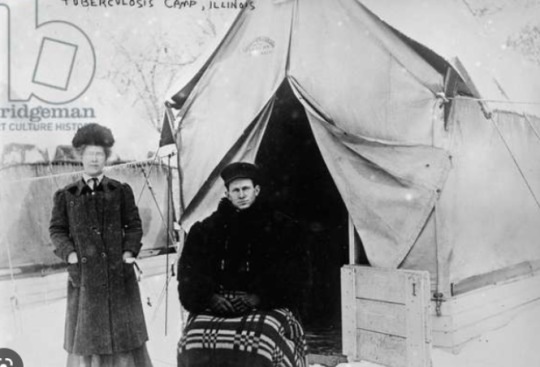
Both the picture above and below would be an example of the tents used by TB patients to camp out. The top picture was probably taken around the 1890s which is Arthur’s lifetime while the picture blow is probably from a later era like the 20′s based on the clothing. City people in big cities sometimes camped out on the roofs of their flats and apartments hence the setting of the second picture.

Due to the extreme fear, people were literally dropped off by families/friends or even government officials far outside of town. You did not want society to know that you had loved one with TB or else the stigma would affect you as well.
Later, TB patients were forcibly institutionalized. Many of these patients were ashamed of their affliction, but also felt further shame that their loved ones could be ostracized by society. I cannot stress enough how horrific this disease was and how tb psychologically affected the sufferer and its loved ones. Many tb sufferers never saw their loved ones again due to their families shunning them. I interviewed the elderly who remembered family members suffering from the disease and it still haunts their lives today. We see some of the shunning and stigma in the game, not just from the townspeople but from the gang. It's actually one of the reasons why I truly dislike a few unexpected gang members, for example.
At least Abigail, Charles, Tilly, John, and Sadie still treated him as a human. Hell, Even Molly was kinder to him and she was really suffering in chapter 6.
I will tell you right now, realistically speaking, in no way could Arthur have done anything at all in chapter six. I’m not only talking missions, but any sort of work. I won't go into graphic details, but one of the less graphic ones is that his hands would struggle to grasp objects, especially a gun. His joints would be too swollen. I know because I've seen it firsthand with my father and read plenty of accounts about it. Other than that, the game does a pretty great job of representing TB - however, Arthur could have been arrested or fined for spitting blood on the street which he did quite often in the game. Link goes to an academic article, but here is a more accessible link.
By 1899, people had been heading west for TB treatment for decades. People of all races headed west to Colorado, California, New Mexico, and Arizona being the prime locations. Dry air and or mountainous air were your best bets. Colorado was quite literally known as THE place for TB tourism as it was called. It was one of the first major waves of health tourism in the history of the USA.
Another famous person and case study is Dr. Edward Livingston Trudeau. He himself suffered from tuberculosis who sent up tuberculosis huts in Saranac Lake, NY. For further study, other key locations include Asheville, North Carolina and in the mountainous regions of Pennsylvania. They huts looked like this:
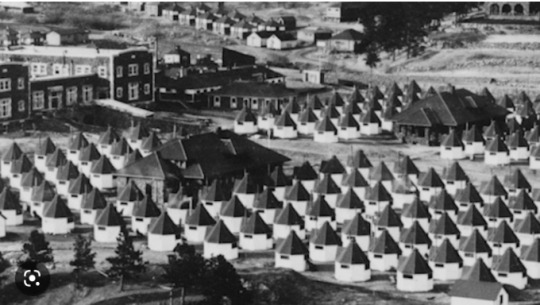
These were also in Colorado Springs, Colorado Springs was full of them and they are still occasionally found in people’s yards today.

I visited one in the Pioneer museum in Colorado Springs. I can post my pictures later, but this is one found in an outdoor museum.
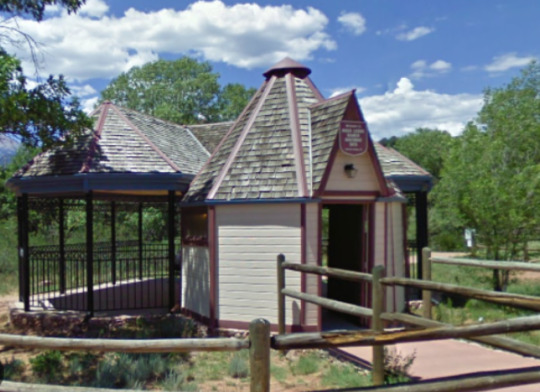
The TB patients had a very strict regimen of never leaving the bed and used bed pans. Healthier patients had access to their own private toilet. Stronger patients could work on doctor approved exercises, while even healthier TB patients who weren't ready to leave facilities yet could spend the rest of their time working around the camp or sanatorium.
Below is how Arthur would have looked getting treatment if he wasn’t in a hut or tent:
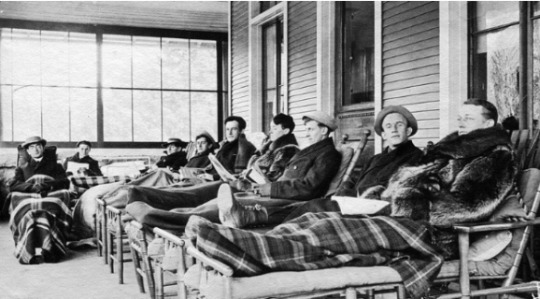

Above: Women receiving treatment. Below: An 1899 TB facility. Most tuberculosis sanitoriums were built from 1905 onwards so John’s era was FULL of them. The peak of the sanitarium era though was 1920-1940ish.
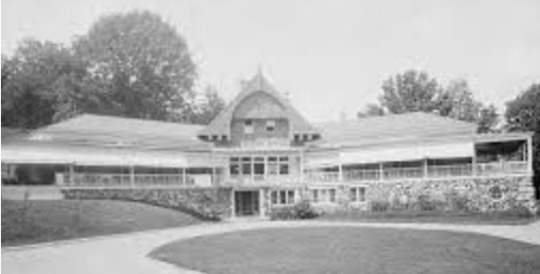
The problem is TB patients had a very chance of suffering from pneumonia once TB went into remission. It's happened in tons of my case studies. If Arthur could have survived both TB AND pneumonia, then he would have been considered "Ok". Not good, but “Ok”. However, I can't predict how long he would have lived afterwards. Some TB patients had tuberculosis come in a second wave. This is, unfortunately, very common. Some people lived a few months, a few years and some lived decades after surviving the second wave.
Fortunately, survival after two waves include people who lived hard, like Arthur. Trudeau lived till 68, and that is after 2 bouts of TB and pneumonia, with the third wave of TB being his cause of death.
This is very likely a reason why Arthur would have been in New Austin if they had kept him in the epilogue and continued the TB storyline. I personally do NOT think John was ever going to kill him.
MISC NOTES:
Related to RDR:
Important side note: Sex workers were especially blamed for spreading TB which makes sense because of the contact with multiple people, but it's not that different than someone who works at a factory every day, runs a shop or works at the docks, or in similar situations. Anyone could spread it. This is why it is actually technically very offensive to ask someone like Abigail if she had TB because it would be a way to imply she is unclean as a person. (Which people in the game already believe with some of the fandom similarly treating her poorly.) The history of sex work is my other specialty, so I am very familiar with their history. I will say, from what I gathered, sex workers did NOT seem to be that much more affected than others, but at the same time, we don't have a lot of records of people who weren't white upper-class Christian men. So we have these records if these people were arrested, but remember that all of the examples of people I mentioned were viewed as second-class citizens. Therefore, we have hardly any records of sex workers as actual people and historians have to be creative to find other ways to research them properly.
Modern day: TB is also becoming antibiotic-resistant at a frightening pace. This will become a massive problem. Treatment requires at least two antibiotics - streptomycin being the main choice for the primary antibiotic. This treatment lasts months, and these antibiotics are insanely strong. They can really mess with the body's system. I've seen it. My father was one of the lucky ones only having to take the pills for 8 months. Many others take it from a year to even 18 months. Other people take the pills and undergo radiation therapy to treat TB. Modern science can't produce enough new antibiotics to outpace it, but alternative treatments do appear to be promising.
If you want me to write more about TB or for any other history questions, feel free to send me an anon/message.
Additional pics:
Below: Sanitarium built around 1905.

Below: An example of a finished Sanatorium in 1911ish:

#rdr 2#arthur morgan#john marston#van der linde gang#red dead redemption 2#abigail marston#abigail roberts#charles smith#sadie adler#mary-beth gaskill#mary linton#wild west history#medical history#history of medicine#19th century history#tw terminal illness#meta#20th century history#tuberculosis#consumption#wild west#doc holliday#long post
786 notes
·
View notes
Text
Florenci Pla Meseguer "La Pastora", intersex antifascist hero
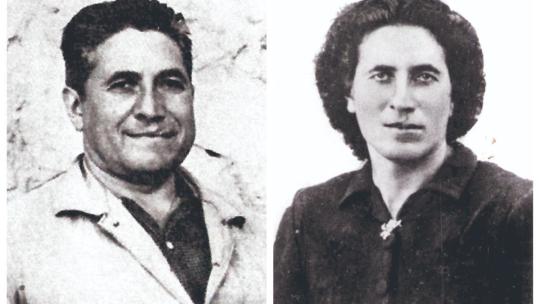
One of the most famous maquis (guerrilla fighters against Franco's dictatorship) is Florenci Pla Maseguer.
(thank you @neonbutchery for the suggestion)
He was born in a farmhouse in Vallibona, in the rural mountains in north of the Valencian Country, in 1917. His body did not fit the categories of either male nor female, so his family were left with the choice of what sex to register him as. His parents decided to register him as female so that he could avoid the mandatory military service.
He grew up in the farmhouse being a shepherd, and never went to school as was usual at the time for the rural working class. When he reached puberty, he developed male secondary sex characteristics.
When the fascists did a coup d'état in 1936, sparking the Spanish Civil War, he wanted offered himself as a volunteer to fight in the republican (=antifascist) army, and he thought that this way he would get officially registered as a man, but couldn't.
He kept dressing as a woman until he was 30 years old, but always felt a man. In his words (originally in Catalan in this interview in El Temps from 1988):
Interviewer: What did you think of your sexual condition? Did it cause you any worries?
Florenci: Problems...? Mainly because of the beard. They said I was half man and half woman, but I never felt a woman. I still remember the first time I dreamed I had an affair with a woman, when I was 13 (...)
I: Have you always felt a man?
F: Always, and I have always liked men's jobs and being registered as a man. In fact, when I walked the flock I carried a sarró [=a kind of bag], like men, and not a basket like women.
He kept wearing women's clothes until he was 30, when he joined the maquis. By then, it was 1947; the fascists had won the war in 1939 and, as a result, Spain and its occupied territories were ruled by Franco's fascist dictatorship, which persecuted the political dissidence, the national minorities (such as Catalans-Valencians) and their languages, and everyone who didn't fit the strict normative and nationalcatholic morale, prominently LGBTQI+ people and women who didn't limit themselves to the roles that the patriarchal society considered fit. The maquis were the armed resistance.
I: How did you change the flock for the maquis?
F: Since I lived in the mountains, I had sometimes talked to them. On a snowy night, three maquis took refuge in a house that was only inhabited in summer -El Cabanil- but one of them ran away -one who was from Morella- and everywhere he went, he spread the word, he snitched it. And the Civil Guard [=the regime's military police] followed their clue until they found them and burned the house down, because they were resisting. The next morning, they arrested El Cabanil's owner and I got nervous because I worked for him, and I decided to escape out of fear of being killed.
I: Was it because of the fear of reprisals or for the humiliations to which the Civil Guard put you through?
F: Yes, that determined it, too. That was on the morning of the same day they burned down El Cabanil, and it was "teniente Mangas" [="lieutenant" Mangas, which he says in Spanish], six guards and two militiamen, one from Torremiró and the other one from Herbesset.
I: And what did they do to you exactly?
F: They were curious to know how could a shepherd girl be half man and half woman. I had sold thrushes to the militiamen, and they told the Civil Guard about my anomaly. Teniente Mangas ignored all rules and made me take off my clothes, until their curiosity was fulfilled. And when they were done, they said "bueno, a hacer bondad" ["well, behave" in Spanish, as a way to say goodbye]. And I felt so much rage, so much helplessness.
(...)
I joined [the guerrilla] and I dressed as a man. There, I was a man like any other.
From then on, he lived as a man and named himself Florenci, though he was known with other nicknames like "Durruti" (after the famous anarchist leader) and, most famously "La Pastora" (the shepherd).
He ended up living in Andorra, but a journalist for the Spanish tabloid El Caso published about him, attributing to him the crimes committed by other maquis, even ones that he had never met. For this reason, La Pastora became famous in all of Spain and the police intensified the search. The Andorran police turned him in to the Spanish police in 1960, accusing him of robbery, banditry and terrorism. He was judged twice for the same crimes: a tribunal sentenced him to 40 years of prison and the other one sentenced him to death and later changed it to 30 years of prison.
He spent 17 years in prison. First, in a women's prison where the women (and him) had to wear very tight miniskirts. He was later moved to a men's jail, where the case was further investigated. The detective saw that there was no proof and that the story didn't match up, so it was impossible that Florenci had committed these crimes. He was freed with a pardon in 1977 and the detective officially registered him as a man.
Despite the slander published by the press, when he came back to his hometown Vallibona, everyone came down to the village from their farmhouses to greet him. He died in 2004, at 86 years old.
Nowadays, Florenci "La Pastora" is by far one of the most famous maquis, if not the single most famous one. He is talked about in songs, books and documentaries, and has become an icon of the antifascist resistance.
#història#país valencià#florenci pla meseguer#la pastora#uselesslgbtfacts#maquis#history#intersex#intersex history#queer history#queer#lgbt history#lgbtq#lgbtq history#antifascist#working class history#antifascism#guerrilla#20th century history
190 notes
·
View notes
Text
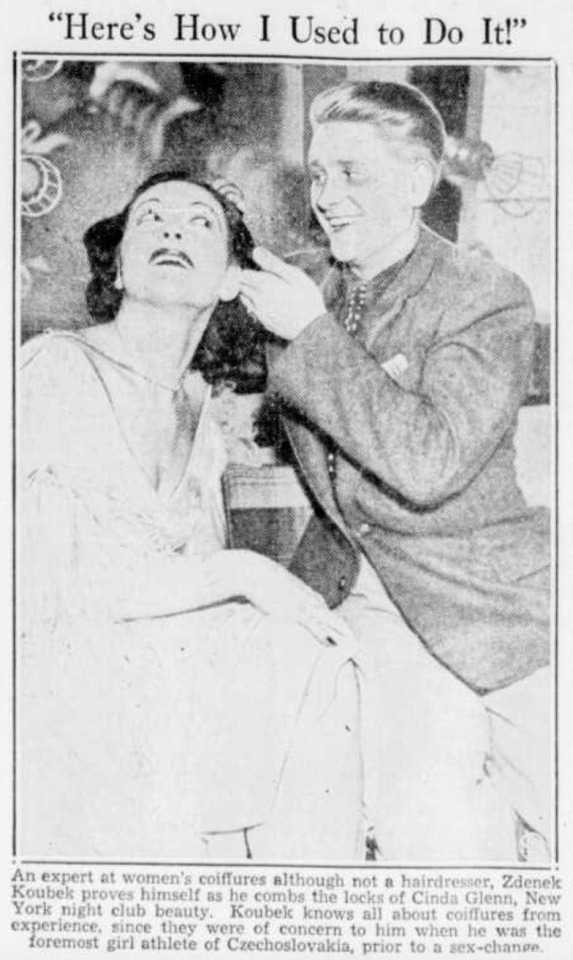
ID: a black and white photo and caption from a newspaper showing a young white trans man with light hair wearing a tweed jacket and high collar smiling at a young white woman in a pale dress as he brushes her mid-length dark hair. She is smiling at him from the slightly complex angle as he brushes her hair. The photo is faded and not great quality but their faces are clear.
The headline over the photo is “Here’s How I Used To Do It!”
The caption below reads “An expert at women's coiffures although not a hairdresser, Zdenek Koubek proves himself as he combs the locks of Cinda Glenn, New York night club beauty. Koubek knows all about coiffures from experience, since they were of concern to him when he was the foremost girl athlete of Czechoslovakia, prior to a sex-change.”
Zdenek Koubek was born in Paskov, Czechoslovakia (at the time) in December 1913, one of eight siblings, and competed as an athlete. With minimal formal training, he began running at age 17, decided to pursue it formally aged 19, and broke two world records at the 1934 world olympics.
Because queer and gender-diverse history is complex, I’m genuinely unsure if Zdenek was intersex. He seems to have been pretty gender-nonconforming when read as a woman in his early life and seems to have retired from athletics because he was harassed by people wanting him to undergo invasive “gender checks” after his gold medals at the 1934 Olympics.
Apparently the current obsession with “defining gender in sport” has roots back to the 1930s. Athletes competing in female athletics have been forced to undergo a variety of examinations for the purpose of declaring them “female enough”. They seem to have never been pleasant, appropriate, or anything other than invasive and dehumanising, and they seem to have always focused on a) defining gender by physicality b) defined that physicality in fairly arbitrary ways that are actually incredibly difficult to relate to anything objective, despite a veneer of scientific objectivity.
I can entirely see why the threat of such harassment would have caused Zdenek to decide an athletic or adjacent career wasn’t worth undergoing it, whether he personally believed himself to be intersex or whether we would recognise him as such today. The term “intersex” has many definitions, and is often challenged by medical professionals if it could potentially cover too many people - e.g. medical professionals have repeatedly challenged the term when used by AFAB people with PCOS, which can cause fertility issues, hirstutism etc, purely on the grounds of “that would make around 10% of women intersex”. Zdenek simply publicly stated “I was wrongly assigned as female at birth” without giving any other details - as he had *every* right to. Some historians have characterised him as intersex based on this, and others simply as trans; he appears, very reasonably, to have preferred to preserve his privacy on the details.
Zdenek went on a lecture tour of the US talking about his life and transitioned in 1936. At the time of this photo, he was pursuing a career in cabaret in the US. He seems to have been reasonably successful but never settled there, returning home and marrying a cis woman with whom he lived happily for the rest of his life, dying in Prague aged 72 in 1986.
He joined a local rugby team along with his brother Jaroslov after WWII and seems to have been an enthusiastic amateur player. I hope he got a lot of joy out of it, which he does seem to have.
Like so many queer and trans histories, Zdenek’s is somewhat obscured because so much of what has been written about him is always skewed by the writer’s own perspectives about gender and transness. Including the drive to impose a false binary on trans experience - which I as a nonbinary person know is certainly not universally present.
There are, of course, *absolutely* trans people who always have a strong feeling of gender equating to “knowing they are a boy/girl from an early age”, and I in no way wish to erase them or their experiences, but it must also be noted and acknowledged there are plenty of us with different experiences. There are people like me who feel “wrong” in our assigned gender from pretty early in life, all the way down to having quite strong dysphoria in puberty and afterwards, but don’t strongly ID as the “opposite” binary gender either. There are people who rub along fine in their assigned gender, or who have many issues with it but don’t know what they equate to, until they have some experience presenting otherwise and suddenly experience strong gender euphoria for the first time in their lives. There are people who never feel anything much at all about gender and only ever do any identifying purely as a matter of convenience because a very binary society requires it.
Cis people seem to find the “always knew/born in the wrong body” narrative the easiest to relate to, and I can only assume that is because it is the narrative that allows them to challenge our society’s gender-essentialist, binarist worldview the *least*. It is considerably easier, and requires much less thought and critical attention, to say “I guess sometimes the occasional person is just mistakenly assigned to the wrong category” than to question those categories, why they exist, what they actually are, how they are imposed, and whether they actually mean anything at all in an objective sense.
I have no idea where Zdenek fell on any of this, or if his experience was very different in another way.
I posted this to, as ever, note that we are not a new phenomenon. Trans people are part of human history. We have always existed. We have always contributed. The way the society we lived in perceived us *and* how the societies our stories have passed through perceived us affect how our stories are told today, and those things can make it complex to uncover the lived experience of the trans person behind all of that. Queer and trans history must always be about acknowledging those facts and uncertainties while doing our best to find out as much as possible about the actual lived experiences of our siblings in the past.
#trans#trans history#queer history#czech history#sports history#historiography#nonbinary#trans historian#nonbinary historian#queer historian#trans man#historical trans man#historical trans person#20th century history#modern history
99 notes
·
View notes
Audio
Listen/purchase: Water Fountains by Highway 80 Stories
During Mike Broussard’s early childhood, his family lived in Shreveport, Louisiana, but later he moved to Vivian where he owned a business and lived out the remainder of his life. The experience described in this song, when Mike was twelve years old, affected his attitude towards race relations from then on.
One of the oldest movie theaters in Shreveport was The Strand. It had different entrances for blacks and whites and water fountains marked for the different races, as well.
During the ’60s, most southern cities had two simultaneous phenomena: demographically a significant percentage of the population was African-American (Shreveport was about 60% black) and as a consequence whites and blacks unofficially interacted a lot. The other aspect was a policy of official segregation. This manifested itself in a myriad of ways beyond the obvious, e.g. separate drinking fountains and different entrances to movie theaters. However, relationships between whites and blacks could be warm and friendly despite official segregation.
Into the demographic mix were other ingredients. Louisiana had a relatively large number of Italian Americans, mostly Sicilians. These immigrants also experienced some discrimination, and in general did not share the otherwise pervasive white attitudes about African-Americans.
When Mike Broussard served in Vietnam he met an African-American from Detroit, D.W. Washington, and they became life-long friends. Mike and D.W. talked about their plans when their tours were over, and D.W. went back to Vivian with Mike and they operated a filling station and auto repair shop for more than forty years. D.W. was Mike’s closest friend.
© 2019 Frank David Leone, Jr./Highway 80 Music (ASCAP). The songs and stories on the Highway 80 Stories website are works of fiction. Names, characters, businesses, places, events, locales, and incidents are either the products of the author’s imagination or used in a fictitious manner. Any resemblance to actual persons, living or dead, or actual events is purely coincidental.
#bandcamp#literature#southern fiction#short stories#20th century history#the 1960s#race relations#coming of age#Shreveport#Louisiana
31 notes
·
View notes
Text
Today i learned three things:
1. Claudette Colvin credited her history teacher's lessons on black women throughout history with inspiring her act of civil disobedience, which helped drive the Montgomery Bus Boycotts
2. When the police arrested 16-year-old Claudette, they also charged her with assault. This fraudulent charge was not expunged from her record until 2021.
3. Claudette Colvin IS STILL ALIVE. She is 84 years old.
#civil rights#civil disobedience#civil rights history#black history#claudette colvin#montgomery bus boycott#history#american history#20th century history
26 notes
·
View notes
Text
2am thoughts: First Impressions on the Titanic Officers
Disclaimer: these are totally random thoughts, and most of these are sort of from the 1997 movie, as you have already guessed (nevertheless I’m not the biggest fan of the movie because the romance is just not my cup of tea). My heart goes to everyone who were involved in this disaster, especially those who have lost their family members in the sinking.
Chief Officer Wilde
goofy ahhh middle name
wait so he’s the actual chief officer????
He looks like that one IKEA bear plushie (and coincidentally I named my own Henry)
100% will hug him
The way he crawled out of the water and blew his whistle in the 1997 movie makes me wished that he’s scooped out of the water 😭
Poor man leaving his tinies behind 😢
1st Officer Murdoch
scrunkly
He looks quite important in the movie
why does he have a lot of fangirls
he just looks like other moustache dudes bro 😭😭😭😭😭 (*am numb after seeing lots of moustache men from my WWI stuff)
2nd Officer Lightoller
awwww he looks sweet like look at his smiley eyes🥺🥺🥺
he looks like a Herbert more than a Charles
he badass, his entire life was an odyssey
oh wait why the fangirls😭😭😭😭😭😭 
 WHY ARE THERE PEOPLE THIRSTING OVER HIM I-
I’m calling him Lightsy😔✨
3rd Officer Pitman
Teddy bear🥺🥺🥺
he SMOL
Where is he in the movie????
4th Officer Boxhall
Very elegant-looking
Prettiest side profile
Awwww look at him at the life buoy🥺🥺🥺
Oooooh he’s from Hull
Give him hugs and kisses🥺
5th Officer Lowe
LOOK AT THIS GOOD BOI
MUST TRY NOT TO PET
awww poor little boi who was ignored on the ship when it collided with the iceberg 😭😭😭
this man got the amount of fans that he deserved
I totally agree with the amount of fangirls for movie Lowe tbh
Ahhhhhh is he the best boi🥺🥺
Let me pet him
LET. ME. PET.
6th Officer Moody
Oooooh he’s from Scarborough, think I’ve passed through his hometown when I took the train to Edinburgh
AWWWW LOOK AT THIS SWEET BABY
Poor young man who has sacrificed his life for others 😢
Please protecc him
PROTECC HIM AT ALL COSTS
He’s a Yorkshire boi, that’s why he got tea with him, period.
I will do a another one with the Marconi duo (Jack Philips & Harold Bride) and other crew members (including Thomas Andrews) if anyone wants a part 2!
#I’m going to try to hype up the mood for Titanic (1997) 25th anniversary rerelease#silly little shitpost#titanic officers#titanic#rms titanic#titanic (1997)#titanic shitposting#20th century history#Henry Wilde#William McMaster Murdoch#william murdoch#Charles Lightoller#Herbert Pitman#Joseph Boxhall#harold lowe#James Paul Moody#James Moody#chief officer dilf#the good boi#Anglo drama queen#soft moustache boi#steve carell on sea#discounted horatio hornblower#gossip boy
56 notes
·
View notes
Text

This picture of the Barmaley Fountain taken by Emmanuil Yevzerikhin on August 23, 1942, conveyed the devastation of the Battle of Stalingrad by juxtaposing a pastoral scene of children dancing around a playful crocodile and the city’s bombed-out, burning buildings in the background.
On the day the photograph was taken, about 40,000 civilians lost their lives to Nazi airstrikes, according to official statistics.
#history#ww2#world war two#stalingrad#soviet union#1940s#b&w#black and white photography#photography#historical photos#black and white#barmaley fountain#volgograd#russia#20th century history#war#destruction#nazi
79 notes
·
View notes
Text
Now I am become death, destroyer of worlds.
— J. Robert Oppenheimer, "father of the atomic bomb." Oppenheimer recalled this line from the Hindu scripture Bhagavad Gita, after witnessing the first nuclear weapon test, known as Trinity.
Now we are all sons of bitches.
— Kenneth Bainbridge, director of the Trinity nuclear weapon test.
#oppenheimer#nuclear weapons#history of nuclear weapons#atomic age#quotes#christopher nolan#cillian murphy#hiroshima and nagasaki#center for nuclear disarmament#20th century history#world war II#world war 2
9 notes
·
View notes
Text



Electronic Media 1990s 20th Century Media History Communication IT Changes World || autradingpost - ebay
2 notes
·
View notes
Text

Photography. P.H. Polk, "Boss Woman". ca 1920s
X
#antique photography#american photography#americana#black americana#20th century history#20th century photography#historical photos#historical photography#historical portrait#moma
9 notes
·
View notes
Note
I assume you heard of what the Real Madrid twitter account posted, how Franco was a supported of Barça? Amazing historical revisionism, as if Catalans weren't tortured or murdered for daring to speak their language, or how even one of the directors of Barça was murdered after being accused of defending the independence of Catalonia.
I'm sure they are aware they're lying, I don't believe someone would be so ignorant to make up something like that and somehow convince themselves of it.
Basically, if someone's not aware of what happened, Real Madrid published a video saying that FC Barcelona (Barça) was favoured by the Spanish fascist dictator Franco, which is false. The team that has always been associated with Francoist beliefs is Real Madrid, so I assume they want to distance themselves from that by accusing their main rival (Barça), who also happens to be a symbol of a minority (Catalans) that was one of the main groups targeted by Spanish fascism.
Some actual historical information about Franco and Barça:
1. In 1939, all football clubs that were federated in the Catalan Federation were banned from playing. All the players' contracts were cancelled. That includes Barça. Some months later, they were reformed and could continue existing with a completely different directors/administration board accepted by the regime. (Women are banned from this position, when Barça had la Sagi.) Copying the model of Mussolini's Italy, the Francoist dictatorship gave control of sports to the Falange (the fascist party, the only party allowed) who controlled everything from the Delegación Nacional de Deportes (National Sports Delegation).
2. For the previous resolution, all of Barça's administratives are ceases and their names and files are given to the military police to control them. The board and administration of all the club was purged.
3. The regime sentenced to death and killed the president of Barça at the time (Josep Sunyol i Garriga) for being pro-Catalan.
The president of Real Madrid (Antonio Ortega) was also killed for being a communist. The difference is that nowadays, since the end of the dictatorship, Barça honours Josep Sunyol, while Madrid acts as if Antonio Ortega had never existed and doesn't have any space dedicated to him. Not only that, but if you look at Real Madrid's website, they leave an empty spot during the years that Antonio Ortega was president (1936-1939), pretending he never was and there simply was no president during those years.
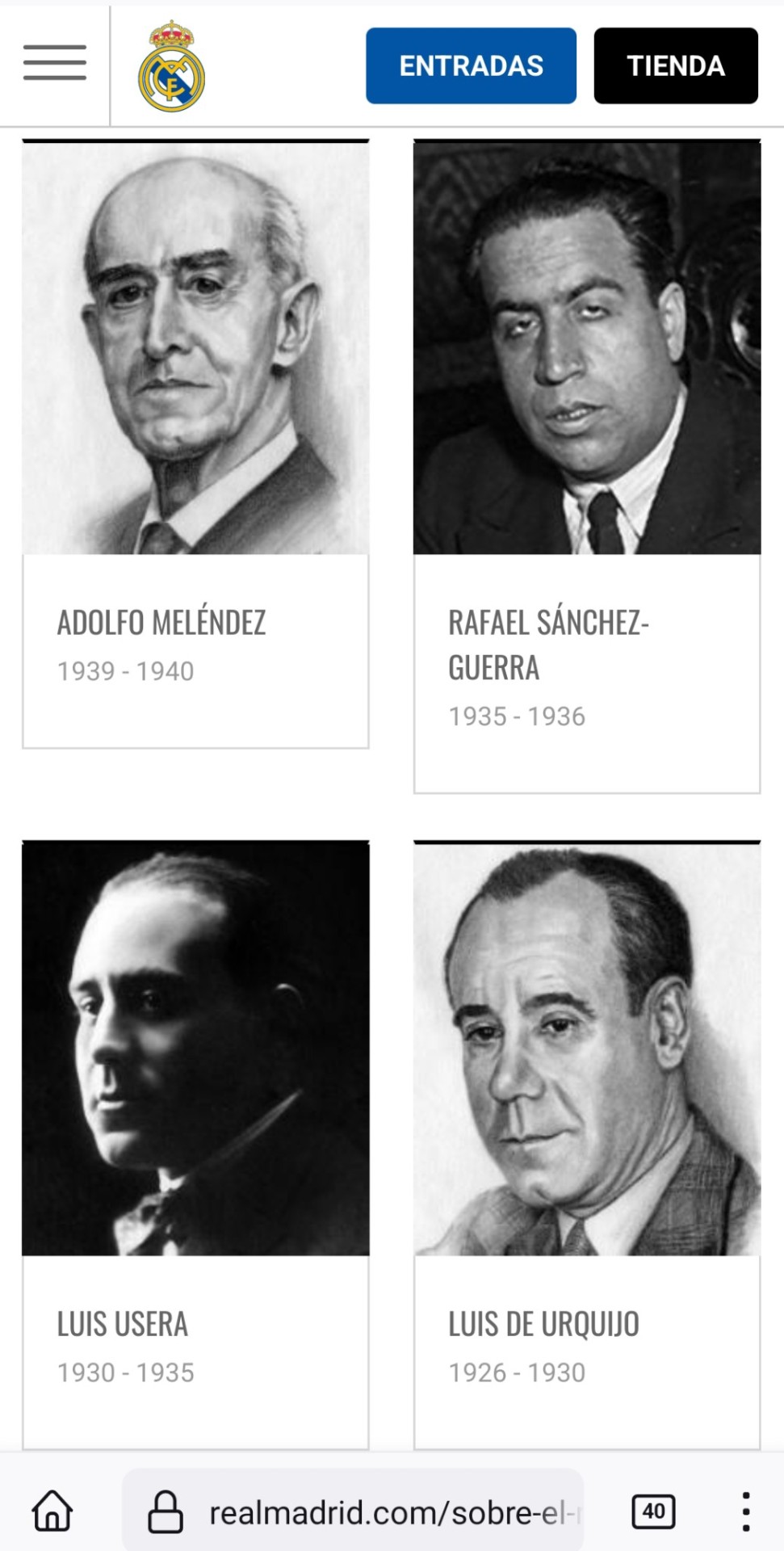
All the opposite, Real Madrid honours Santiago Bernabéu (the team's stadium is named after him), who worked to bring Real Madrid closer to the dictatorship. Even before Franco gained power, in the 1920s, he said that Real Madrid defends "the Spanish pride and cause". He later enlisted in the Spanish army and joined the fascists in their coup d'etat that led to the Spanish Civil War.
4. Barça had to change their entrance tickets and their name to Spanish following Franco's illegalization of the Catalan language. It stoped being called "Futbol Club Barcelona" (Catalan) and had to be called "Club de Fútbol Barcelona" (Spanish). Consequently, the letters in the club's shield were consequently changed from F.C.B. to C.F.B. The club wouldn't get their original Catalan name back until 1973.
5. Removed the Catalan flag from Barça's shield. They had to have 2 red bars instead of the 4 bars of the Catalan flag. Later they could get it back because Barça's shield is based on the shield of the city of Barcelona, so they alleged it's just a symbol of the city.

6. Instrumentalized Barça and Athletic de Bilbao against Catalan and Basque people, since the regime identified Barça and Athletic de Bilbao as the teams that symbolise these two minority nations and their independentism. Their first match after the war was scheduled by the regime, a Barça vs Athletic de Bilbao where the whole stadium was wrapped in huge Spanish flags and were various fascist gave speeches in favour of Franco and Spanish unity, including the general Álvarez-Arenas who talked about the purges by saying he praised Barça for "having thrown away forever the anti-Spanish seed, exposing their idea of what sport entities must be patriotically, the true healthy sport to educate the masses" ("que ha sabido arrojar para siempre la semilla de los antiespañoles, exponiendo su idea de lo que patrióticamente han de ser las entidades deportivas, el verdadero n del deporte sano y educativo de multitudes").
7. The regime abolished the Catalonia League, where Barça played.
8. More purges in Barça followed after that first one. The dictatorship carried out in-depth investigations into Barça's directives and members to find people who fought for Catalan rights. Some people were accused for being in the Barça directive. Here's some extracts from the letter where the leader of the fascist police in Barcelona, Luis Martí Olivares, sent to order the arrest of some Barça directives and to order them to be taken to Madrid for trial:
In front of the statue of Casanovas, they used to celebrate acts of separatist affirmation [...]. All the directives, players and members [of Futbol Club Barcelona] have always attended it with flower crowns, offerings with the shield of the "F.C. BARCELONA"
Another one by him:
It's publicly known that the "F.C. BARCELONA" has always been political, at the beginning pro-Catalan and since a long time ago frankly separatist and for this reason they have exploited their rivalry with R.C.D. ESPAÑOL, which has been precisely the only Football Club in Catalonia that has signified themselves as a true pro-Spanish. In the matches between these two Clubs, the Barcelona fans considered the Spanishists to be foreigners, because they spoke in Spanish.
After the purges, the new dictatorship-approved directive board of Barça was made (for the 1st time in the club's history) of people who were not even members of the club. Many of them were fervent Espanyol fans, not Barça fans.
Most of their first decisions were political, including the fact that they removed the club's founder Joan Gamper as honorary president and declared the new honorary president to be the Spanish fascist general Múgica.
They also made the players taka a flower crown to the founder of Spanish fascism José Antonio Primo de Rivera, which had the Spanish flag and the Barça flag and inscription "F.C. Barcelona to José Antonio".
One of Barça's directors during the dictatorship was actually a paying Espanyol member during his time as Barça president, another director was an army general that was appointed directed by the higher spheres of the dictatorship and who openly said he was directing Barça simply because "as soldier with discipline I'm following orders".
9. Finally, in June 1946, the members of the Barça board who were actually Barça fans and cared for the club mass resigned and pressured the director to stop being a club under direct control of the dictatorship's government. Their protest resulted in the end of the regime's direct intervention, and after 10 years Barça could go back to having a new directive board, this time mostly made up of people who had always been Barça fans, though the regime still only allowed people who were officially approved.
So while Barça was directed by people who didn't care about the club and who were very badly coordinated and later was starting to re-order itself (still only with approved people), Real Madrid had its golden age, under the director Santiago Bernabéu (who was defined as "he's what Philip II was to Spain: its best king" and as we've explained before was a fascist) and a director board that had close ties to the fascist government.
The club that was most favoured by the regime during its first years was Atlético de Madrid (at the time called Atlético Aviación) which was related to the Army. But the president of Real Madrid Santiago Bernabéu got the club closer to the dictatorship and made it become the regime's favourite from the late 1950s on. Real Madrid played a very important role in fascist Spain's public relations, because that's the historical period that ended the autarchy and when fascist Spain was accepted in the UN and kept the dictatorship with the agreement of the other countries. Real Madrid acted as a political and cultural ambassador of fascist Spain in other countries. In return it received favours from the dictatorship. For example, the regime changed the sports clubs' status so that Madrid could hire Alfredo Di Stefano instead of Barça in 1953. Barça had already closed the case and the club and the player were ready to sign, but the dictatorship's direct intervention stopped it.
10. Since speaking Catalan was banned, some Catalan traditions were banned, even some Catalan songs were banned, and everyone was forced to be Spanish and a Spanish nationalist, with the National-Catholic morale imposed in every aspect of life, Barça became the place to express Catalanity. People used to go cheer for Barça as the "allowed"/hidden way of cheering against Francoism and in favour of Catalonia. This sentiment was well represented by the song "Botifarra de pagès" by the Catalan humour band La Trinca, which they released in 1974:
youtube
If you don't speak Catalan, the whole song is about how Catalans cheer for Barça as a representation of cheering for Catalan rights and link how well Barça is doing at the time with Catalanism ("l'any que ve no farem riure, visca Catalunya ------" = "next year we [Barça] won't be laughable, long live free Catalonia!" with a peeeeeep over where the word "free" woul have been) with cultural references. For example, they sing the tempo of sardanes with the name Cruyff, and change the famous quote "som i serem gent catalana, tant si es vol com si no es vol" (we are and we will be Catalan people, wether they want it or not) from the song La santa espina (song forbidden during Franco's dictatorship) with "som i serem socis del Barça, tan si es vol com si no es vol" (we are and we will be Barça fans, wether they want it or not).
11. Regardless of the club's significance to the population (because, let's be honest, everyone knew what Barça meant), it was still a club that existed under a fascist dictatorship. During the dictatorship, only approved or appointed people held office and had the power to take decisions. And if you were in that position were you had been approved, even if you had your secret political beliefs and actions, there was only so much you could do in public before getting fired, arrested, banned for life from your job, get you and your family on a watchlist and likely get tortured.
One of the "unwritten rules" during the dictatorship was that anyone who created a prize or medal had to give the 1st to Franco. Barça did that too, but they have later addressed it and taken it back.
12. In the semifinals of 1942-1943 season, Barça won against Real Madrid by 3-0. On the return match, the dictatorship's police went down to the dressing rooms to intimidate the Barça players so they would let Madrid win. The result was 11-1 (Madrid victory), which effectively gave victory of the league to Real Madrid.
13. Dictator Franco, personally, was a follower of Real Madrid. It's known that he used to comment the lineups with his officers.
---------
Since Real Madrid published that video some days ago, so many Spanish newspapers, magazines and TV channels have talked at length about how Barça actually helped Franco. They use as excuse the fact that the Barça under the dictatorship's control (because remember that the dictatorship chose who would lead the team, even when these people weren't Barça fans it only mattered that they were fascists) gave condecorations to the regime officials. This is worth remembering and worth criticizing, but this says more about the dictatorship than it says about Barça, especially if they want it to represent nowadays Barça. Because the thing is that this is no secret, and Barça has already addressed it in the past: in 2019, Barça officially withdrew all the medals given to Franco officials. Real Madrid still honours fascists and erases their antifascist director, and knows that they're a symbol of Spanish nationalism.
However, it seems like the people who so quickly want to run to talk shit about anything that has to do with Catalonia don't usually keep the same energy to criticize the dictatorship itself and how it intervened every aspect of life, crushing dissidence and national minorities in everything, even their hobbies, nor to make the same criticisms of Real Madrid, because it's not just about Barça but a way to attack Catalan society.
#ask#anonymous#futbol#història#barça#esports#futbol club barcelona#fc barcelona#barca#football#european football#la liga#history#sports history#francoism#1940s#20th century history#spain#barcelona
187 notes
·
View notes
Text
Yoshiya Nobuko (1896-1973)

Yoshiya was born in 1896 in Niigata, Japan, the only daughter in a family of five children—an upbringing that had an impact on her approach to gender roles, and her resentment of the male domination of society. In 1915, Yoshiya moved to Tokyo, where she resided for the rest of her life. She began attending meetings of Seitō, Japan’s pioneering feminist magazine, where she met other modern female writers attempting to carve out lives not beholden to men. With the support of this community, she cut her hair into an unconventionally short bob and began to wear men’s clothing.
Just a year later, Yoshiya published a 52-story collection called Hana monogatari. Translated into English as Flower Tales, the collection details intense emotional relationships between girls—and introduced many of the motifs and symbols that define modern shōjo manga, such as the boarding school dormitory setting, imagery involving Western flowers, and a dreamily wistful style of writing. Yoshiya used flowers, most often roses, to symbolize the emotional intensity of these girls’ relationships. Each story was paired with an illustration by the famed artist and doll creator Jun’ichi Nakahara, who drew schoolgirls with the huge, bubbly eyes so characteristic of manga and anime today. Most of the Flower Tales concern unrequited crushes or longing among women, often for another student or a teacher.
These stories soared in popularity and cemented Yoshiya’s place among the canon of popular Japanese writers. According to Sarah Frederick, a professor of Japanese literature at Boston University, Yoshiya’s stories can be read two ways: as queer (though they hold back from anything more shockingly sexual than a kiss) or as purely, if intensely, platonic.
In 1919, shortly after Flower Tales, Yoshiya wrote one of her best-known—and most scrutinized—stories, ”Yaneura no nishojo” (“Two Virgins in the Attic”). Many critics read it as quasi-autobiographical, as it follows two students, Akiko and Tamaki, who feel like outcasts in their dormitory. They spend all their time in a triangular attic, where they develop a romantic longing. They spy on each other in the bathroom and smell each other’s scent of “lily magnolia”—all culminating in a kiss. Urban Japanese architecture has a notable lack of attics, yet they commonly appear in modern-day shōjos—a lineage almost directly traceable to Yoshiya.
Many manga scholars consider “Two Virgins in the Attic” to be the first prototype of yuri manga, the modern extension of shōjo that is more explicitly focused on lesbian romantic and sexual relationships, according to Hiromi Tsuchiya-Dollase, a professor of Japanese at Vassar College. Though yuri is now considered a genre in its own right, some of the most popular shōjo mangas of all time, including Sailor Moon, have subplots that veer into yuri.
Read more at: https://www.atlasobscura.com/articles/yoshiya-nobuko-queer-manga
#women in history#asian women in history#20th century history#1900s#japanese women in history#women in art#lesbian history#queer history
18 notes
·
View notes
Text
Does anyone have any good sources for information about early 20th century France (specifically the 1900s-10s)? I’m mostly looking for stuff about the culture (art, music, science, etc) and to a lesser extent, the politics of the time.
#history#french history#20th century#20th century history#1900s#pablo picasso#albert einstein#france
2 notes
·
View notes
Text
[Free eBook] Men Without Maps: Some Gay Males of the Generation Before Stonewall by John Ibson [LGBTQ 20th C History]
Men Without Maps: Some Gay Males of the Generation Before Stonewall by John Ibson, an emeritus professor of American Studies at California State University, is an LGBTQ+ studies history book, free for a limited time courtesy of the University of Chicago Press.
This is their featured Free Book of the Month for June, and is a history/sociology book examining the experiences of gay men during the timespan just before World War II through to the early 1970s, who had few positive role models for same-sex relationships and identities before the advent of the gay rights movements, exploring the various ways in which both couples and single men managed to express themselves in their private lives without the benefit of public guidance.
Offered worldwide through the month of June, available directly from the publisher's website.
Currently free @ [the university's dedicated promo page] (https://press.uchicago.edu/books/freeEbook.html) (PDF available with download options for both Adobe Digital Editions and Readium DRM, follow instructions provided on download link page, requires newsletter signup with valid email address), and you can read more about the book on its regular catalogue page.
Description
In Men without Maps, John Ibson uncovers the experiences of men after World War II who had same-sex desires but few affirmative models of how to build identities and relationships. Though heterosexual men had plenty of cultural maps—provided by nearly every engine of social and popular culture—gay men mostly lacked such guides in the years before parades, organizations, and publications for queer persons. Surveying the years from shortly before the war up to the gay rights movement of the late 1960s and early ’70s, Ibson considers male couples, who balanced domestic contentment with exterior repression, as well as single men, whose solitary lives illuminate unexplored aspects of the queer experience. Men without Maps shows how, in spite of the obstacles they faced, midcentury gay men found ways to assemble their lives and senses of self at a time of limited acceptance.
3 notes
·
View notes
Link
From @5w33p3r comes Viva La Revolucionaria, a nice combo of older and more recent components.
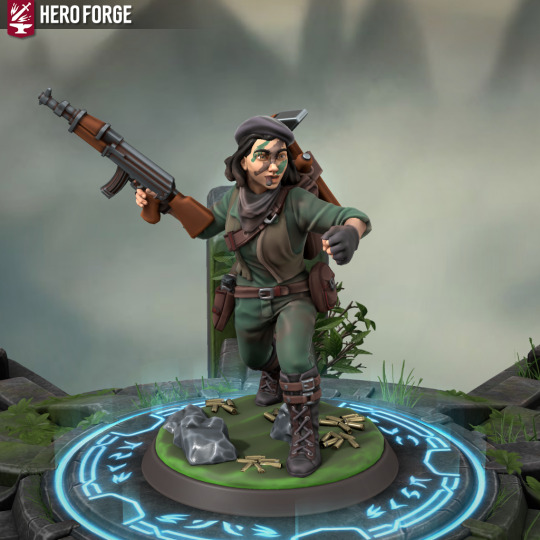
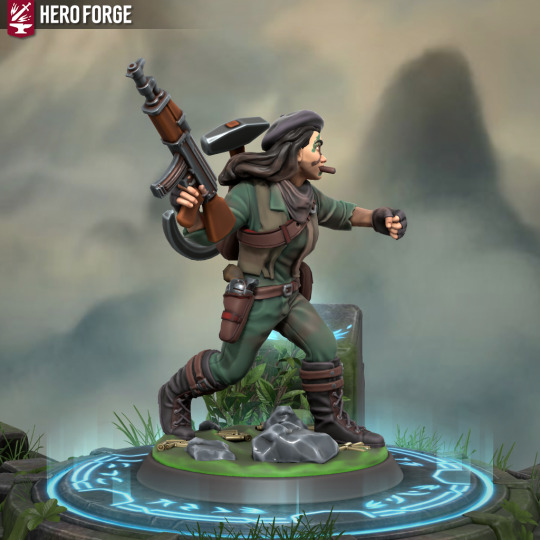
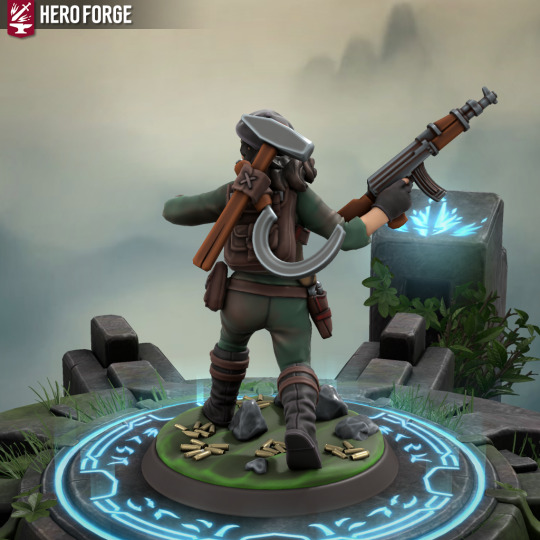
The hammer and sickle is a nice touch
#hero forge#miniatures#5w33p3r#communist revolutionary#20th century history#guns & bullets#cigar#ak-47#miniature
7 notes
·
View notes